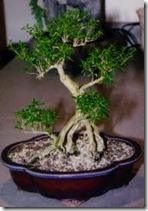 Before you start learning bonsai basics, you should know that bonsai tree cultivation is a Japanese tradition stretching back hundreds of years. Translating literally to “tray planting,” growing a bonsai tree involves actively working to shape a tree into a dwarfed, artistic version of itself.
Before you start learning bonsai basics, you should know that bonsai tree cultivation is a Japanese tradition stretching back hundreds of years. Translating literally to “tray planting,” growing a bonsai tree involves actively working to shape a tree into a dwarfed, artistic version of itself.
A bonsai tree is not a special dwarf or hybrid species of a common tree; they’re genetically identical to their bigger brothers and sisters. It’s the careful cultivation that keeps these trees small. Surprisingly, the trees are not damaged by this process, however. In fact, with the proper attention to bonsai basics, the bonsai version of a tree can exceed the life expectancy of the same tree if it were grown in the wild.
Bonsai basics start with growing a tree either from seeds or from cuttings of trees. They normally range in height from two inches to three feet. Through pruning both branches and roots bonsai trees are kept small. Additionally, new growth is frequently removed when they are periodically repotted.
There is a much about art as there is about horticulture in learning about bonsai basics. Not only are bonsai trees kept miniture, they are also shaped into pleasing forms. They often follow a number of different growth patterns, from simple triangles to waterfall shapes cascading down over their pots. The shapes are normally a result of both the pruning of the tree and by the wrapping the trunk and branches with wire, pushing the tree into its desired shape. Chosen to compliment the color and shape of the tree itself, the pots are also part of the art of bonsai basics. Rocks and mosses are often added to the base for aesthetic appeal.
Bonsai basics is much more involved than maintaining most houseplants. Since the bonsai has has a smaller root system than most plants, it needs fertilizer and water more frequently than the majority of garden-variety houseplants. Occasional pruning is also essential, since without pruning the bonsai tree would grow into just a normal size tree. Also, if wire is used to help mold and form the tree, it is important to take care that the wire doesn’t dig into the bark of the tree, scarring the branches permanently.
Depending on the type of indoor bonsai trees and your climate, you may be able to keep some bonsai trees outside year round, while others will need to be kept inside for at least part of the year. Since moisture in the soil, leaves, and branches of the bonsai is one of the most important bonsai basics, they need to be misted occasionally if they are to develop healthily.

Deprecated: strpos(): Passing null to parameter #1 ($haystack) of type string is deprecated in /home/agriviek8Qv/agriviet.net/public_html/wp-includes/comment-template.php on line 2522